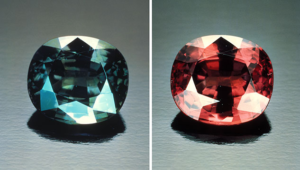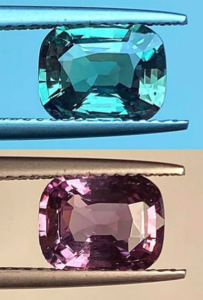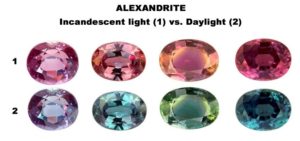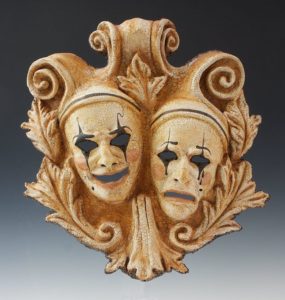What is so rare as a day in June?
The answer: Alexandrite, the most mercurial shape-shifter of the gemstone world.
This choice will make even more sense when you realize we’re talking about Gemini. Yes, a few Geminis arrive in May, but just as May is really Taurus country, June belongs to the double-trouble quicksilver Twins. Both the birthstone and the sun sign are known for their duality if not duplicity, which is why Alexandrite is called “Emerald by day, Ruby by night.” Alexandrite, a gem-quality chrysoberyl, famously exhibits pleochroism, meaning that the stone changes color depending upon the light source. The color-change ability, called the Alexandrite Effect, occasionally shows up in other gemstones as well, including Sapphires, but this chameleon quality is most often associated with Alexandrite.

Like so many of our favorite jewels, the first recorded discovery of Alexandrite was made in Russia’s Ural Mountains. In 1834, a crew of miners were digging for Emeralds, and simply presumed that the raw hunk of Alexandrite they unearthed was simply one of the green gems well-loved by the Tsarina and her court. However, as the night went on, the gemstone miraculously changed from deep pine green to a purply wine-red, coincidentally the colors of Russia’s Imperial flag. The gem was promptly named for Czar Alexander II, and demand from the ruling class basically exhausted the then-known supply of the trickster gem by the century’s turn.

The color change of Alexandrite is actually an optical illusion, because the gem does not literally change color within itself. It’s a matter of mineralogical trompe l’oeil of the highest order. The crystal formation is capable of absorbing both red and blue light, depending on the light source. Because the human eye evolved to see shades of green best, which are closer to the blue (short) light spectrum, Alexandrite will appear blue-green in natural outdoor light, where at high noon especially daylight is basically neutral (neither red nor blue). When you bring Alexandrite indoors, where the light is incandescent (longer wave-lengths, towards the red end of the spectrum), there’s less blue or green to absorb, so Alexandrite reflects a yummy, plummy raspberry jam hue.

The specific colors present in a color-change gem are dictated by the concentrations of chromium, gallium, aluminum, titanium, iron and other metals in the soil while the stone is forming. Of course, this is relatively recent news in terms of gem appreciation. Color-change in other gems was observed in antiquity, and regarded as supernatural, long before science decoded the mystery. Accounts from the ancient world credit lightning strikes as the origin of pleochroism, reasoning that the gems were transported to earth via shafts of celestial fire. Roman emperors hired sorcerers when planning military campaigns, calling upon their bewitching color-change stones as a sort of Magic 8-Ball to predict snowstorms and other disasters. In Renaissance Florence, physicians to the Medicis used color-change gems to test food and drink for poison.
Hardness and clarity are among the top criteria used to evaluate most gems, but in the case of Alexandrite, the ability to display two highly distinct shades is the most critical factor. Even a grainy or opaque Alexandrite may be highly valued if the stone produces a radical switch of colors when moved from daylight to incandescent or firelight. Alexandrite is rated as a hard and durable stone at 8.5 on the Mohs scale, making it suitable for daily wear. Modern deposits of Alexandrite are now found in Brazil, Sri Lanka, India, Myanmar, and various parts of Africa, and stones from each of these regions offer a slightly different double-dip of paired colors. Brazilian Alexandrites are paler in hue than the Russian specimens, but produce a sharp contrast in their shades, making them the most desirable of the new wave of Alexandrites.

(Castor and Pollux)
Which brings us to Gemini, ruled by the planet Mercury, the switch-hitter-double-agent of the zodiac (May 21- June 20). The sign is represented by the twin brothers, Castor and Pollux. Castor, a tamer of horses, symbolizes endings, while Pollux, a boxer, signifies immortality. But this is all a bit heavy for Gemini, a mutable Air sign whose interests and loyalties can flip at the flick of a switch. Another Greco-Roman icon which resonates for Gemini are the classical masks of comedy and tragedy, called Thalia and Melpomene, for their respective Muses, by theatre wonks. La Donna È Mobile. Easily-bored Gemini is prone to floaty fickleness, snap decisions and sudden mood swings. And beneath that Holly-Go-Lightly exterior, the laughing mask may hide tears, since Gemini is secretly prone to deep depression.
This sign’s emotional depth may not be immediately apparent, since Gemini is a master of the mask. But keep in mind that Hermes, the Grecian counterpart to Mercury, invented the lyre, and this legacy gives Gemini a uniquely poetic and lyrical nature, making Gemini an irresistible seducer and a most romantic lover.

The Gemini response to the first flicker of sadness? More parties, more champagne, book that flight to Ibiza, STAT! This June baby is the original social butterfly. Gemini is the world’s most sparkling, charming party-guest, with a multi-tasking hummingbird’s flitting attention-span and a rapid-fire mind that skitters effortlessly from celeb gossip and current events to politics to the arts without taking a breath—Geminis always have the gift of gab.
This is significant, since Gemini rules the throat and lungs. With this in mind, Gemini (in particular) needs to be cognizant of the hazards of smoking. In Traditional Chinese Medicine, the lungs are associated with the emotion of deep grief, and in spite of the easy-breezy affect of Gemini, this sign is no stranger to despair. Geminis who smoke often develop deep grooves under each cheekbone, another signal from TCM indicating lung issues and unresolved sorrow.
The sign’s dual nature also makes Gemini indecisive, and the Twins may be plagued by regret and buyer’s remorse following any sort of transaction. Gemini is the sort who will snap up a fabulous party-frock on Monday, return it on Tuesday, then panic on Wednesday because she hasn’t a thing to wear to the black-tie gala that night, will then borrow a son’s slightly-too-small Bar Mitzvah suit from a neighbor, pair it with stilettos and shoulder-duster earrings, and steal the show. The sign is irreverent and slightly unhinged, and when all is well, Gemini hurtles through the cosmos at the speed of fun.
Looking back to ancient Greece, Hermes, the Olympian predecessor of Mercury, was honored as the the prankster god of thievery for stealing a herd of cattle from his half-brother, Apollo. Gemini is not an especially skilled liar – we’ll leave that to Scorpio – but the sign may annoy more stodgy types (Earth signs) by seeming scattered, flighty, flaky, superficial and non-committal– all classic characteristics of Air Signs in general (Libra, Aquarius) and Gemini in particular. Gemini is an avoider, and is skilled at deftly avoiding discomfort.
If you’re in love with a Gemini– and who isn’t?– be forewarned that Gemini’s idea of domesticity is room service. The Twins are made for life in the fast lane, so evenings at home with reruns of “The Office” will set Mercury’s winged sandals to itching. This sign loves, no, NEEDS a little frisson of risk to offset the daily helping of routine– after all, the god Hermes rules the realm of gambling and is credited as being the inventor of those tumblin’ dice. You’ll have to remind Gemini not to text and drive (yes, Gemini is a scofflaw), and as for taking out the garbage, you’re on your own.
Although Gemini has the speediest synapses in the zodiac, this sign has trouble concentrating and often does not “test” well, meaning that as a partner or parent, you may find yourself constantly nagging Geminis to clean their room and write their book report for Monday morning, keeping in mind that it was Gemini who first coined the phrase, “The dog ate my homework.”

Gemini is better-equipped to stand and give an extemporaneous riff on the meaning of democracy, versus diligently hitting the books to pass the bar. Luckily, some metaphysical types recommend that Gemini wear Alexandrite to correct a tendency toward procrastination.
Hermes, then Mercury are the gods of travel, so if you’re Gemini, the past two years of semi-quarantine have been sheer torture in terms of isolation and lack of stimulation. Treat yourself to a well-deserved birthday jaunt to a favorite vacay spot or a new destination, and don’t forget to write!
Next month: Get crabby with the Ruby-loving Moonchild in July !
__
Photo: Gemstone photos are from pexels.com. Historic photos of antiquities are from Wikimedia Commons.




